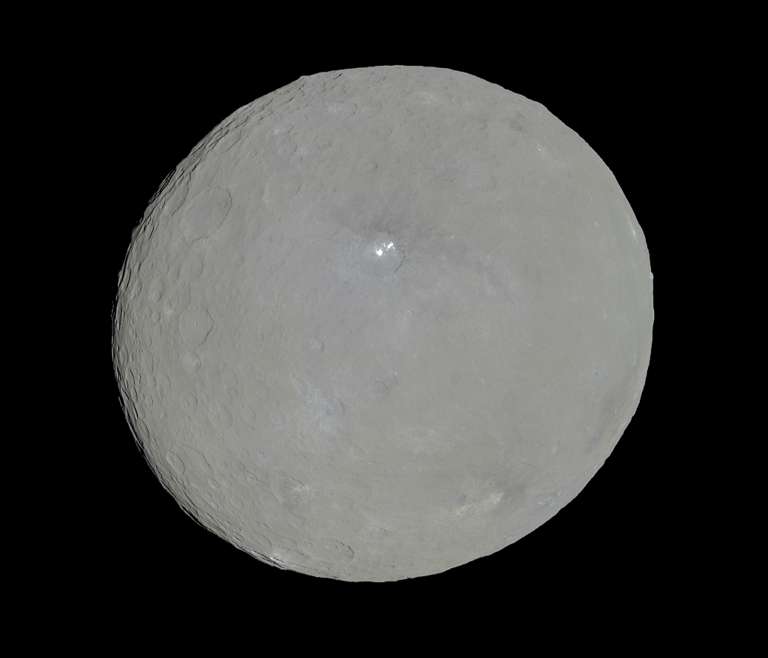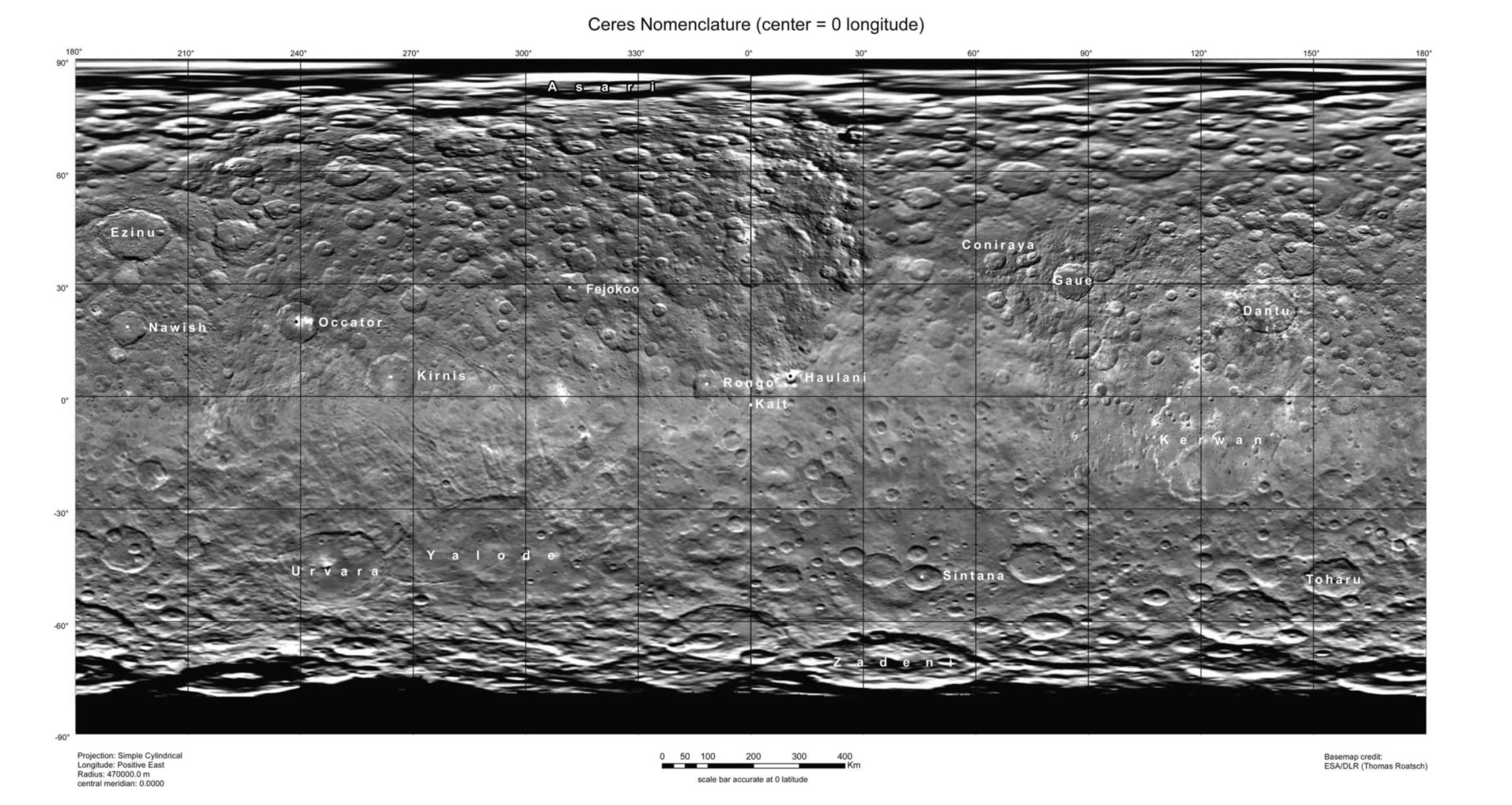Emily Lakdawalla • Nov 12, 2015
DPS 2015: First reconnaissance of Ceres by Dawn
Most of the news coming out of the first couple of days of the Division for Planetary Sciences meeting was about Pluto, but there are several other missions actively returning new data right now, notably Dawn and Rosetta. This is the first major meeting since Dawn's arrival at Ceres, and despite competition with Pluto surface science there was a well-attended Ceres session on Monday and lively poster session on Tuesday. I wish I had time to illustrate this post better, but I have to get back to the meeting and talks on giant planets and icy moons!

First, here are some global properties of Ceres, as reported in a poster by Ryan Park and coauthors. The mass is slightly higher than previously thought, so the density is also slightly higher, but the difference is minor. The density is significantly less than that of silicate rock, so the Dawn team knew they were approaching a world that contained a significant quantity of water ice.
- Volume: 434 ± 2 x 10^6 km^3
- Mass: 9.38463 ± 0.00008 x10^20 kg
- Density 2161 ± 9 kg/m^3
- No observed offset between center of figure and center of mass
- Shape is consistent with hydrostatic equilibrium
- No moons observed despite very deep searches.
Carol Raymond gave an overview talk, discussing many of the surprises revealed about Ceres after Dawn's first complete global survey of the dwarf planet. If Ceres has a lot of water ice, and if it differentiated into a rockier interior and icier crust upon formation, you would expect Ceres' surface to be very smooth, with little topography. That's because ice is not structurally strong enough to hold up tall mountains over geologic time at the temperatures that prevail in the main asteroid belt. In fact, ice isn't stable over most of the surface of Ceres -- it gets warm enough to sublimate -- so there has to be at least a thin layer of rock-rich material at the surface to shield ice from the temperature variations that would make it go away. And the oblate shape of Ceres has confirmed that Ceres has at least some mass concentration toward its center; it is differentiated. So they expected to see craters like those on Enceladus or Ganymede, where the bowl-shaped topography was replaced by a flat floor with only a ring to mark the original location of the crater.
When Dawn approached, the team was surprised by how much topography there was. Michael Bland reported topographic variations of plus or minus 7 kilometers. This is much more than on Ganymede or Enceladus. It's more like Iapetus, which has been much colder for much longer than Ceres. Bland showed that you just can't support such topography without a substantial amount of rock in the upper layer -- more than 60% rock. "The takeaway message," he said, "is that Ceres interior is more like icy dirt than dirty ice."

Ceres is fairly heavily cratered, but it has fewer large impact basins than predicted, and it's not clear why. There are three main large ones: Kerwan, Urvara, and Yalode. All three have unusual-looking interiors and associated tectonic features. Kerwan is associated with an extensive region of terrain that is smoother and less cratered than the rest of Ceres. Raymond said that the lack of large basins could indicate that larger craters have relaxed away (unlike the smaller ones), but the audience wasn't particularly satisfied with this explanation; if a crater floor rebounds over time to smooth out the globe, there is always rim topography left to indicate where the basin was in the first place.
The highly variable morphology of the craters on Ceres is another puzzle. Raymond said this was evidence for a crust whose composition and structure varies from place to place. She proposed a model to explain that: Ceres began with a water ice layer at the surface (including some fine silicate material and salt impurities) over a layer of a less-differentiated, hydrated-silica core. Impact gardening -- whereby holes of different depths and sizes are dug randomly over the surface with variable depths, tossing various proportions of ice and rock to the surface at various distances from the crater -- has churned the crust into a mix of ice, rock, salt hydrates, and frozen brines that varies from place to place.
A few talks concerned Ceres' surface composition, based on work with the VIR spectrometer and camera color filters. Before Dawn arrived, there was spectral evidence for brucite (a magnesium hydroxide) on Ceres' surface. But Carlé Pieters explained that Dawn's spectrometer can see to longer wavelengths and the spectra that Dawn is getting are no longer consistent with brucite. Instead, the Dawn team has concluded that they're looking at ammonia-bearing clay minerals, which is just weird. I've never heard of such things mentioned as the component of a planetary surface before.
The problem with ammonia on Ceres is that it's thought to need an outer solar system source. In other words, either Ceres is covered with gunk from outer solar system impactors, or Ceres itself originated in the outer solar system and was transported to its current orbital position by the same solar system kablooie that scattered most of the trans-Neptunian objects. I spent fifteen minutes at the poster session listening to Pieters and Tom McCord argue amicably about whether the ammonia really required an outer solar system source (McCord thinks it can be explained through petrology with an outer main belt origin, while Pieters thinks you can't explain ammonia being observed globally without an outer solar system origin). In his talk, Simone Marchi explored whether an outer solar system origin for Ceres -- and a late capture into the asteroid belt -- could be used to explain the relative lack of large basins, but he said even that is not sufficient to explain the low numbers of craters.
At the poster session, I asked dynamicist Bill Bottke what he thinks of a potential outer solar system origin for Ceres. It's apparently not out of the question; it is possible to start with a large body beyond Neptune and transport it inward in all the wild events that happened during solar system formation. You can even end up with a relatively circular orbit, as Ceres has. But he said it's hard to do that without capturing a lot more stuff from the outer solar system while you're at it. Which would imply that a lot of the dark objects in the asteroid belt didn't actually form in the asteroid belt. It's an interesting area for future work, he said.
There were a couple of talks and posters on the interesting geomorphology of Ceres' surface. Jennifer Scully gave Britney Schmidt's presentation on flow-like features on Ceres. They see two quite different types of flows on Ceres. One looks a lot like Martian rampart craters; they originate at crater rims, are very thin (tens of meters thick), run to 25 or 30 kilometers in length, and have "lobelettes" at floe toes. They interpret these to be localized fluidized ejecta formed during or after high-velocity impacts, "because you need high energy to mobilize material in this way, and we think they require a lot of ice." At the other end of the spectrum are flows that originate from slumps, are thicker (hundreds of meters thick), shorter (about 10 kilometers long), often have parallel furrows on their surfaces, have a distinctive, steep toe, and no lobelettes. They interpret these features to be ice-cored or ice-cemented creeping flows. These may also be initiated when impacts hit a slope and warm the subsurface, but the flow is relatively gradual. Both types of flows are not found on Vesta, so Scully suggested that Ceres' crustal material is weaker, flows more rapidly, and melts more easily. It requires about 30 to 40% for these sorts of flows to happen -- which is nicely consistent with previous talks. The flow in the 3D image below is the example of a steep-toed, likely ice-creep flow that they showed.

Jennifer Scully and Debra Buczkowski presented adjacent posters on preliminary geologic mapping of Ceres. I talked to them for a bit about how strange Ahuna mons is and why aren't there any other features like that on Ceres? Scully told me there's another candidate feature similar to it close to the north pole, but it's hard to see because the illumination is poor. Hanna Sizemore had a poster looking at smaller mounds found all over Ceres, and showed they likely had a variety of origins -- some are just preexisting topography embayed by impact melt (like you see in mounds on the Moon), but others could have a pingo-like origin, and some could conceivably be volcanic. I talked with Buczkowski for a while about the fractures on Ceres. She showed on her map how many of them seem radial to Urvara, but when you continue to map them you realize that they actually form a much larger set of parallel extensional fractures that happen to be radial to Urvara in just one location; they appear to postdate Urvara. You can even see the same geographic orientation showing up in the walls of some of Ceres' notably polygonal craters.
By now I know several of you are probably asking: what about the bright spots? They haven't been easy for Dawn to investigate, because Ceres is so very dark; exposure settings that allow the visible-light instruments to see most of Ceres' surface were too long for the bright spots, and they saturated the detectors, making compositional data useless. Pieters said they had to get special data in order to get the bright spots onto the scale. Even so, it's still not obvious what they are. Maybe salt, maybe ice, maybe a little of both. Stefan Schroeder showed that the brightest area has a yellowish spectrum (low reflectance in blue, higher in green and red), with a possible absorption feature at 850 nanometers, but it's not clear what that would be. Some of the secondary white spots have "perfectly neutral spectra" with "no features whatsoever." It could be salt, but it's not a lot of evidence to go on. Paul Hayne showed that although water ice isn't stable on the surface of Ceres over geologic time, it can last tens of thousands of years, so in fact Ceres has less exposed ice from recent impact craters than he expected. This is yet another argument for a rock-rich crust for Ceres.
I think Ceres is an intriguing little world, and it's fun that it's generating puzzles for so many different kinds of scientists: cratering people, dynamicists, structural geologists, petrologists, spectroscopists. This is going to be a very productive mission, and they're just getting started!
Support our core enterprises
Your support powers our mission to explore worlds, find life, and defend Earth. You make all the difference when you make a gift. Give today!
Donate

 Explore Worlds
Explore Worlds Find Life
Find Life Defend Earth
Defend Earth

